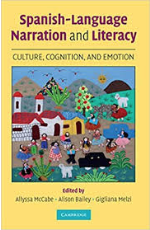To help explain individual differences in language development, Paola Uccelli’s studies have documented sociocultural and individual differences in young children’s narratives and have examined narrative talk and other forms of young children’s extended talk (e.g., explanations, pretense) as developmental precursors of later language development.
Language learning as enculturation: Young monolingual Spanish learners
 Paola Uccelli’s early research contributed to the view of language development as socialization into the culturally valued practices of children’s own communities.
Paola Uccelli’s early research contributed to the view of language development as socialization into the culturally valued practices of children’s own communities.
Inspired by the work of S. B. Heath, Sarah Michaels, A. McCabe, E. Ochs, and C. Snow, her analysis of young Andean Spanish-speaking children’s personal narratives offered an alternative culturally/linguistically relevant heuristic to understand child narrative development in a field mostly dominated by Anglo-centric tools and views of child development (Uccelli, 2008).
Her longitudinal analysis of Spanish-speaking toddlers (followed biweekly from age 2 to age 3 while they co-constructed narratives with their caregivers) documented patterns of concurrent development in vocabulary, grammar and discourse that were similar across children, as well individual differences in narrative discourse already present by age 3 (Uccelli, 2009; 2014).
These studies of young Spanish learners as they communicated their own meanings in caring and supportive interactions contribute to the view of children’s earliest narratives as cultural artifacts and of narrative co-construction as a socialization context in which the concurrent development of lexico-syntactic and discourse skills unfold in similar and unique ways across children from early on.
Extended talk as developmental precursor: Children’s own contributions
Other studies have examined the hypothesis that toddlers’ opportunities to participate in extended talk (i.e., narratives, discussions of feelings or future plans) predict their later language development.
These studies extend research on parental input by offering evidence that toddlers’ own production of non-present extended talk during supportive interactions with caregivers predict their later language proficiency.
In an early collaborative longitudinal study, we examined early language production as precursor of narrative skills at age 5. We found that toddlers who produced more non-present talk during parent-child interactions displayed higher narrative skills at age 5. In comparing children’s personal narratives vs. fantasy narration, we found that toddlers who participated in more imaginary play as toddlers displayed higher genre-specific skills in fantasy narration at age 5 (Uccelli, Hemphill, Pan, & Snow, 2005).
In collaboration with the longitudinal language development study from the University of Chicago led by Susan Goldin-Meadow, we examined toddlers’ non-present talk as predictors of their academic language skills in 7th grade. We found that 30-month-old children who produced more narrative, explanation or pretense utterances in dialogue with their parents displayed a higher mastery of academic language 10 years later (even after accounting for the contribution of socio-economic status, parent non-present talk, child amount of talk, child vocabulary, child syntactic comprehension and parent vocabulary richness at child age 30 months) (Uccelli, Demir-Lira, Rowe, Levine, & Goldin-Meadow, 2018).
